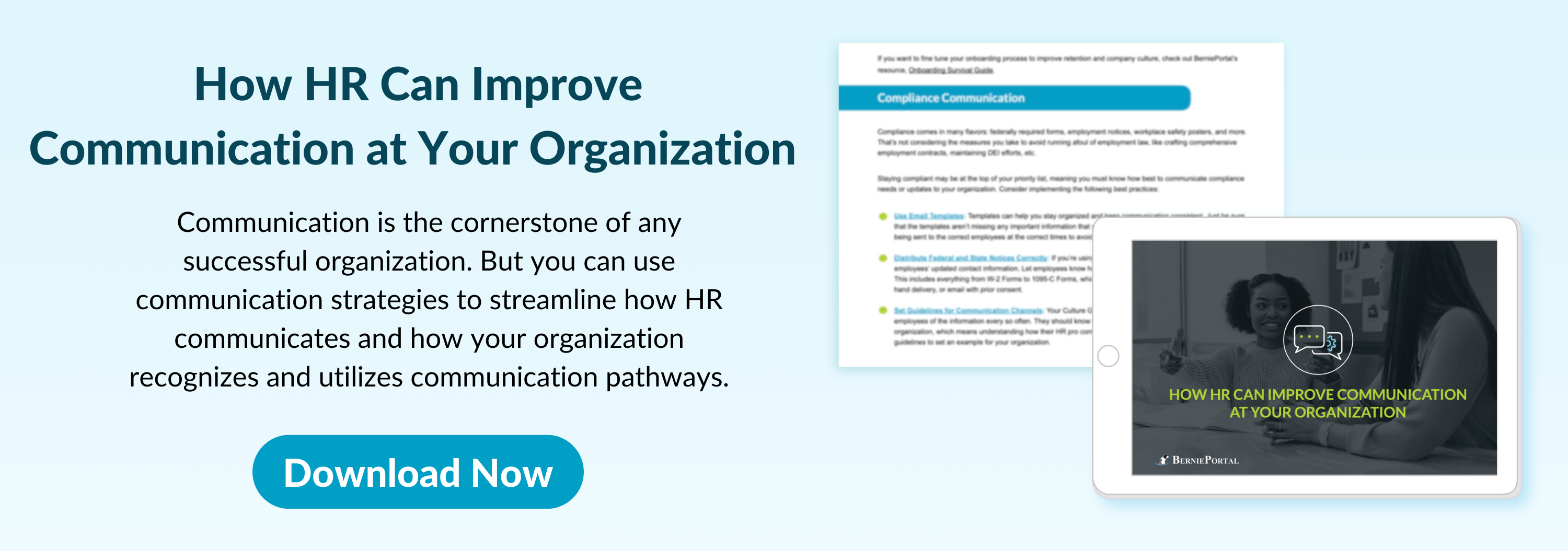
Written by
Katie Shpak
Katie is the leader of the marketing team at BerniePortal. She oversees all content creation.
How to Handle Anger in the Workplace

We have all gone to work in a bad mood. Maybe you got into an argument with a spouse or significant other. Perhaps you were up all night with a sick child and are absolutely exhausted. Or, maybe you just had one of those mornings - ya know, the ones where you’re sprinting out the door, spill your coffee in the process, don’t have time for breakfast, and definitely didn’t brush your hair or your teeth.
Yup. You are in a GREAT mood…
Chances are high, you don’t walk into work with a huge smile on your face.
But—what happens when you DO go to work with a huge smile, and a colleague is quick to swipe that smile clean off your face?
Do you drop-kick them? Punch them in the face?
Kidding, obviously. Even though we have all probably felt the need to take a boxing class after work on occasion!
So–what DO you do? Let’s dive into some tips on how to handle workplace frustrations. But first, let’s walk through a “fun” scenario.
The Frustrating Colleague
You arrive at work in a great mood. It has been a wonderful morning; you got up early, went for a run, had time to make breakfast, and have a cup of coffee before work. There is no traffic on your way into the office, and you arrive early. It is going to be a great day.
But, then…
You begin to catch up on emails, and you receive one from Greg. You have been helping Greg, for weeks now, with benefits options during your open enrollment period. You have sent Greg the following:
- Plan information for each of his options (Greg is the director of marketing, so he has many options).
- In-depth information on the difference between each benefit offered (you sent him this blog on FSAs, but he still came to your office for an in-person explanation).
- Spreadsheets with crunched numbers to compare how each plan may affect his biweekly paycheck (you did this for each plan offered at your organization).
It is now 7:47 a.m., and this email from Greg reads as such:
Good Evening,
Thanks for the information on each insurance plan. I’m still not sure I’m ready to choose, is there any way to get together and discuss in person?
Thanks,
Greg
Greg has had the foresight and nerve to cc your boss on his polite email.
The reality of your HR role, and of work culture anywhere, is that despite Greg’s frustrating requests and how he goes over your head, you must remain calm and professional in your response. So, let’s go over how to respond to Greg without saying what you’re really thinking, and why your professionalism via email matters.
Why is the Tone of Emails Important?
According to a survey conducted by the e-learning company, Preply, 73% of over 1,200 participants responded that they receive passive-aggressive communication at work; 52% of them claim to experience it weekly, if not more often. Whether the passive-aggression is intentional, or merely a matter of perception, it can certainly present issues within the workplace.
The bottom line is that tone matters in your communications.
Toxic communication can directly affect retention in the workplace. According to Colene Rogers, author of Retention: Key Mindsets that Retain Top Talent and CEO of Retention Architects, healthy communication in the workplace leads to high retention rates. She spoke in depth about the importance of communication during the Weekdays With Bernie 2023 Conference. Read the following blog for more on Colene Roger’s presentation, The Future of HR: Strategic Partnerships that Create Acquisition, Engagement and Retention Solutions.
How to Eliminate Toxic Emails in the Workplace
It’s very easy to allow outside stressors and frustrations to impact the way we respond to others. It is also possible for the Gregs of the world to get under our skin. When writing emails, it is important to avoid expressing these emotions and to keep a friendly tone.
So, you may be thinking, “Well, Katie—that’s great advice and all, but it’s not easy to stifle anger at the drop of a hat.”
And your thoughts would be extremely valid! It certainly is no easy task to present a friendly demeanor when feeling anything but cordial.
So—what are some steps you, and others in your organization, can take to eliminate toxic emails in your workplace?
-
Determine whether or not the email is urgent. More often than not, an email is not a platform that requires immediate attention. If you are having a bad day, wait to respond to emails until tomorrow. If the particular person and/or email is the source of your frustration, continue reading through some other options.
-
Take a breather. Go for a walk, get some fresh air, and think through the best way to respond. We have all been in arguments before. Remember those arguments that could have been much less controversial (or nonexistent) if some time and space transpired, prior to communicating about the issue? Time away from the situation can mitigate the level of anger and frustration, enabling you to return to work and respond in a much more tranquil manner.
-
Use the phone! That’s right—it can be that simple. Sure, one’s tone may be negative on the phone, but it allows for an open communication platform. While a call can portray similar emotions, it can just as quickly eradicate them. A written medium can struggle to convey the correct tone; hearing someone’s voice can provide the reassurance they need.
-
Do not send the email without proofreading it first. How does it sound? If you received that email, how would you feel? Put yourself in the recipient’s shoes.
-
Have a co-worker read through your email prior to sending it. It never hurts to have an extra set of eyes in order to ensure the tone doesn’t come across as annoyed or disparaging.
6. Create a roadmap of “do’s” and “don'ts” when sending emails. This roadmap can always serve as a guide for those moments when anger may have taken root. At BerniePortal, we provide a “how to write emails” section within our Culture Guide. Here are a few examples we include:
Forwarding: as a rule, don’t do it. No exceptions when your recipient is a client. There can be exceptions internally, but only when corresponding with someone whom you regularly correspond and the forwarded email is exceptionally clear.
Not respond: the beautiful double-negative. Don’t not respond.
Anger: don’t write or send emails when you’re angry—which, leads to the last, and
probably most important tip...
7. DO NOT SEND AN EMAIL ANGRY! :) When all else fails, simply do not send an email when you are angry.
If you are concerned about establishing a healthy degree of communication at your workplace, we have a resource for you (below): How HR Can Improve Communication at Your Organization. This e-book can help you create a standardized communication pathway, so your employees understand how and when to respond to emails.
Additional HR Resources
You can stay informed, educated, and up-to-date with important HR topics using BerniePortal’s comprehensive resources:
-
BernieU—free online HR courses, approved for SHRM and HRCI recertification credits
-
Resource Library—tools, templates, and checklists on an extensive list of HR topics
-
BerniePortal Blog—a one-stop shop for HR industry news
-
HR Glossary—featuring the most common HR terms, acronyms, and compliance
-
HR Party of One—our popular YouTube series and podcast, covering emerging HR trends and enduring HR topics

Written by
Katie Shpak
Katie is the leader of the marketing team at BerniePortal. She oversees all content creation.
Related Posts
The modern workplace is a dynamic arena where four distinct generations—Baby Boomers, Gen...
Yes, you probably do. But don’t panic—this doesn’t mean you need to be the love police,...
The impact of AI in the workplace largely depends on who oversees its use, if anyone....
Summer is upon us, and while we all love the sunny days and vacation vibes, keeping...









Submit a Comment